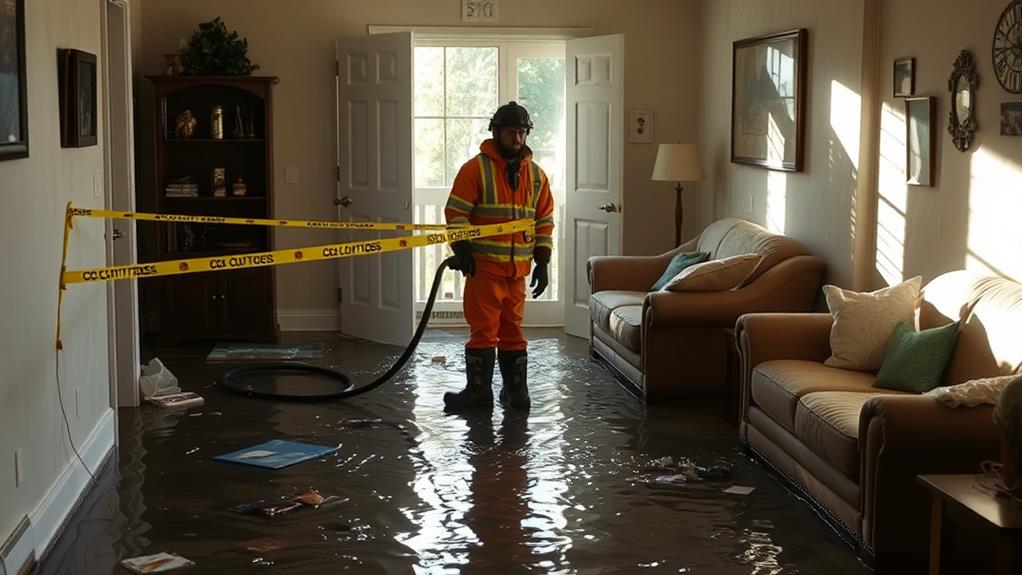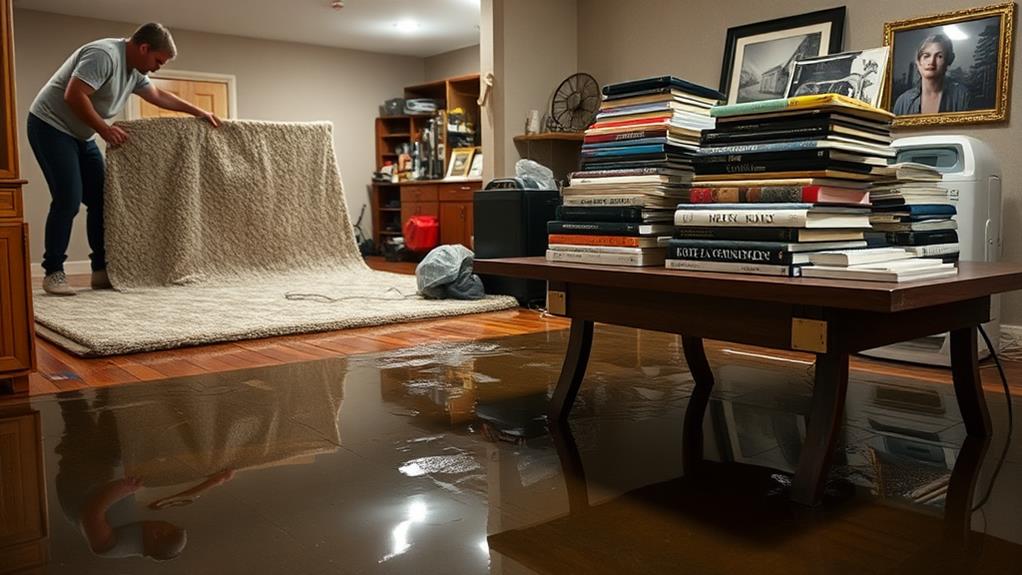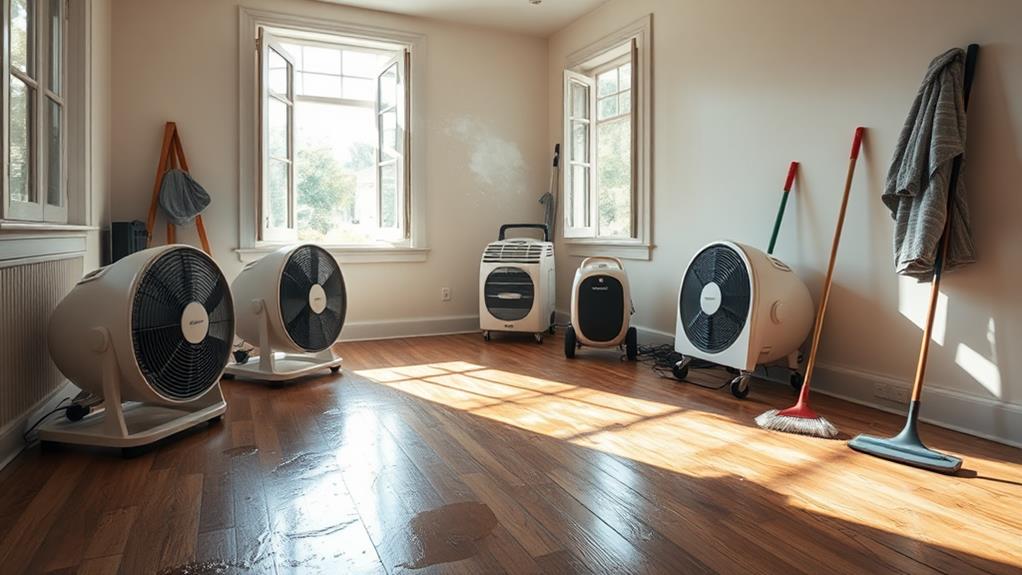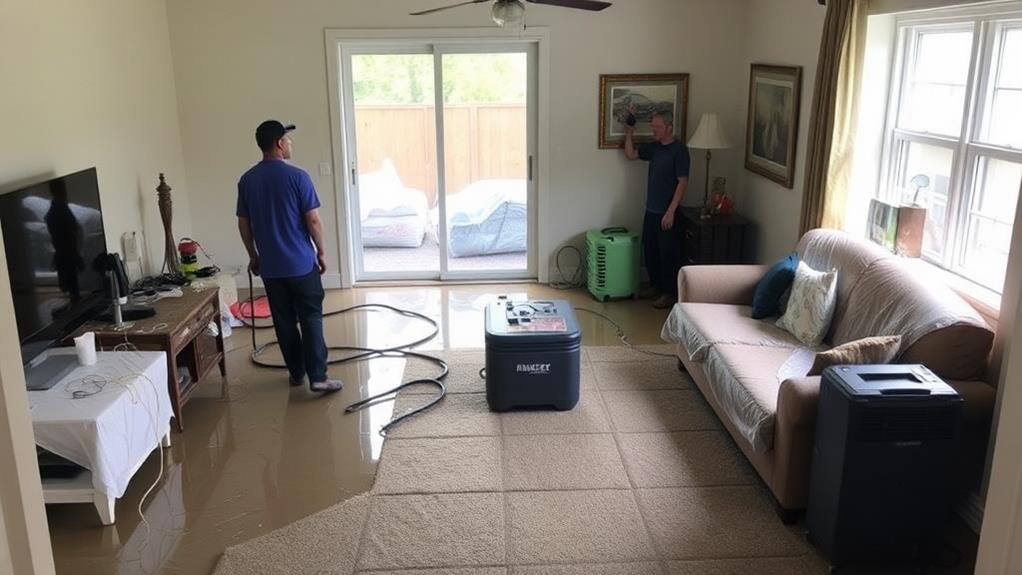When removing standing water from your house, safety is paramount. Turn off electricity and wear protective gear before entering the flooded area. Identify and address the water source to prevent further damage. Remove valuable items and electronics to dry areas. For water extraction, use buckets, mops, or pumps depending on the volume. Open windows and use fans and dehumidifiers to accelerate drying. Clean and disinfect affected surfaces thoroughly. To prevent future incidents, maintain gutters, inspect plumbing regularly, and consider installing water detection devices. This quick guide covers the essentials, but there's much more to learn about effective water damage mitigation.
Safety First

Before attempting to remove standing water from your house, safety must be your top priority. Floodwater can pose serious health and safety risks, including electrical hazards, contamination, and structural damage.
First, ensure that the electricity to the affected area is turned off at the main breaker to prevent electrocution. If you're unsure about the electrical safety, contact a professional electrician.
Wear appropriate personal protective equipment (PPE) before entering the flooded area. This includes waterproof boots, rubber gloves, and protective eyewear. A respirator or face mask may also be necessary to guard against airborne contaminants. Be aware that standing water may contain sewage, chemicals, or other hazardous materials.
Check for structural damage before entering the affected area. Look for signs of foundation cracks, warped floors, or sagging ceilings. If you suspect any structural instability, evacuate immediately and contact a building inspector. Watch out for hidden dangers such as submerged objects, slippery surfaces, or weakened flooring. Use a solid stick or pole to probe the area ahead of you as you move through the water. If possible, work with a partner for added safety and assistance.
Identify the Water Source
With safety precautions in place, the next step is to identify the source of the standing water. Determining the origin of the water is crucial for effective removal and prevention of future incidents. Common sources include burst pipes, leaking appliances, roof leaks, or external flooding.
Inspect visible plumbing fixtures and appliances for signs of leakage, such as puddles or wet areas around their bases. Check ceilings and walls for water stains or bulges, which may indicate a roof leak or burst pipe within the structure. If the water appears to be coming from outside, examine doors, windows, and foundation walls for potential entry points.
For less obvious sources, consider using moisture meters or thermal imaging cameras to detect hidden water pockets. If the source remains elusive, consult a professional plumber or water damage specialist. They can employ advanced techniques like pressure testing or video pipe inspection to locate the problem.
Once identified, take immediate action to stop the water flow if possible. This may involve shutting off the main water supply, repairing a leak, or addressing external drainage issues. Prompt identification and mitigation of the water source will minimize damage and facilitate more effective water removal.
Remove Valuable Items

Safety and preservation are paramount when dealing with standing water in your home. Once you've identified the water source, the next critical step is to remove valuable items from the affected area.
Start by unplugging and removing all electronic devices, including computers, televisions, and small appliances. These items are particularly susceptible to water damage and can pose electrical hazards if left in standing water.
Next, focus on removing furniture, especially wooden pieces that can warp or develop mold when exposed to moisture. Prioritize antiques, heirlooms, and irreplaceable items. Remove rugs, curtains, and other textiles, as these can quickly absorb water and become breeding grounds for mold and mildew. Don't forget to salvage important documents, photographs, and artwork. If possible, move these items to a dry, elevated area of your home or to a safe off-site location.
For items that are too heavy or difficult to move, try to elevate them using concrete blocks or wooden pallets. This can help minimize damage if the water level rises. Remember to wear protective gear, such as rubber boots and gloves, when handling items in or near standing water to prevent potential contamination or injury.
Water Extraction Methods
Once valuable items have been secured, the crucial task of water extraction begins. Several methods are available, depending on the severity of the flooding and the resources at hand.
For minor flooding, manual removal using buckets, mops, and towels can be effective. This approach is labor-intensive but requires no specialized equipment.
For larger volumes of water, submersible pumps are essential. These pumps can be rented from hardware stores and quickly remove standing water, discharging it outside the affected area.
Wet/dry vacuums are versatile tools for extracting water from various surfaces, including carpets and upholstery. They're particularly useful for removing residual moisture after initial pumping.
For extensive flooding, professional-grade water extractors may be necessary. These powerful machines can remove large quantities of water and are often used by restoration companies.
Dehumidifiers play a crucial role in the final stages of water extraction, removing excess moisture from the air and preventing mold growth.
In severe cases, specialized truck-mounted extraction units may be required. These industrial-strength systems can handle large-scale water removal efficiently, making them ideal for commercial properties or severely flooded homes.
Drying and Dehumidifying

After water extraction, the critical process of drying and dehumidifying begins. This step is crucial to prevent mold growth, structural damage, and lingering odors. Start by opening all windows and doors to promote air circulation, if weather permits.
Use high-powered fans strategically placed to move air across wet surfaces, accelerating evaporation.
Dehumidifiers are essential for removing excess moisture from the air. Place them in the most affected areas, ensuring proper drainage or frequent emptying of water collection tanks. For larger spaces or severe water damage, consider renting industrial-grade dehumidifiers.
Monitor humidity levels using a hygrometer, aiming for 30-50% relative humidity. Pay special attention to hidden areas like wall cavities, crawl spaces, and under flooring. Use moisture meters to track the drying progress of different materials.
For carpets and upholstery, employ specialized drying techniques such as float drying or tent drying. Remove baseboards and drill small holes in drywall to allow air circulation within wall cavities. Hardwood floors may require specialized drying mats to prevent warping.
Continue the drying process until all affected materials return to their normal moisture content levels, typically 2-3 days for minor incidents and up to several weeks for major flooding.
Cleaning and Sanitizing
With the affected areas thoroughly dried, the focus shifts to cleaning and sanitizing. This step is crucial to prevent mold growth and eliminate harmful bacteria that may have been present in the standing water. Begin by removing any remaining debris and mud from the affected surfaces.
For non-porous surfaces like tiles, concrete, or sealed wood, use a mixture of hot water and a non-ammonia detergent to scrub the area thoroughly. Follow this with a disinfectant solution, such as a mixture of one cup of bleach per gallon of water. Allow the disinfectant to remain on the surface for at least 10 minutes before rinsing.
Porous materials like drywall, carpets, and unsealed wood may need to be removed and replaced if they've been submerged for an extended period. If salvageable, clean these items with appropriate cleaning products and ensure they dry completely.
Pay special attention to areas prone to moisture retention, such as corners, crevices, and joints. Use a HEPA-filtered vacuum to remove any remaining dust or debris. Finally, maintain good ventilation throughout the cleaning process and wear protective gear, including gloves, masks, and eye protection, to ensure your safety while handling potentially contaminated materials.
Preventing Future Water Damage

Having addressed the immediate aftermath of standing water, it's crucial to implement measures that prevent future water damage. Begin by identifying and repairing the source of the water intrusion, whether it's a leaky roof, faulty plumbing, or poor drainage around your home's foundation. Install and maintain gutters and downspouts to direct water away from your house, and ensure proper grading of your property to facilitate water runoff.
Regularly inspect and maintain your home's plumbing system, including pipes, faucets, and appliances. Consider installing water detection devices in flood-prone areas of your home, which can alert you to potential leaks or flooding. Seal any cracks or gaps in your home's foundation, walls, and windows to prevent water infiltration.
In areas prone to flooding, consider installing a sump pump system with a battery backup to remove excess water. Elevate valuable items and electrical components in basements or lower levels of your home. Finally, review your homeowner's insurance policy to ensure adequate coverage for water damage, and consider purchasing additional flood insurance if you live in a high-risk area.
Frequently Asked Questions
How Long Does It Typically Take for a House to Dry Completely?
The time for a house to dry completely varies depending on factors such as humidity, ventilation, and the extent of water damage. Generally, it can take anywhere from 24 hours to several weeks for thorough drying to occur.
Can I Use Regular Household Fans Instead of Professional-Grade Air Movers?
While every cloud has a silver lining, using regular household fans instead of professional-grade air movers isn't ideal. They lack the power and efficiency needed for effective water damage restoration. Professional equipment is strongly recommended for optimal results.
Will My Homeowner's Insurance Cover Water Damage Cleanup Costs?
Coverage for water damage cleanup costs typically depends on your specific homeowner's insurance policy. Many policies cover sudden, accidental water damage, but may exclude damage from flooding or long-term leaks. Review your policy or contact your insurer for details.
Is It Necessary to Replace All Wet Drywall and Insulation?
Studies show that 98% of water-damaged homes develop mold within 48 hours. Regarding wet drywall and insulation, it's generally necessary to replace them to prevent mold growth and structural damage. However, consult a professional for specific recommendations.
How Can I Detect Hidden Moisture in Walls After Water Removal?
To detect hidden moisture in walls after water removal, use moisture meters, infrared cameras, or thermal imaging devices. These tools can identify damp areas within walls without causing damage. Professional inspection services are also available for comprehensive moisture assessment.
Conclusion
In conclusion, swift action is paramount when dealing with standing water in a home. By following a structured approach—from ensuring safety to implementing preventive measures—homeowners can effectively mitigate water damage. Like a well-oiled machine, each step in the process plays a crucial role in restoring the property to its former state. Proper extraction, drying, and sanitizing are essential to prevent long-term issues such as mold growth and structural damage, ultimately safeguarding the home and its inhabitants.

